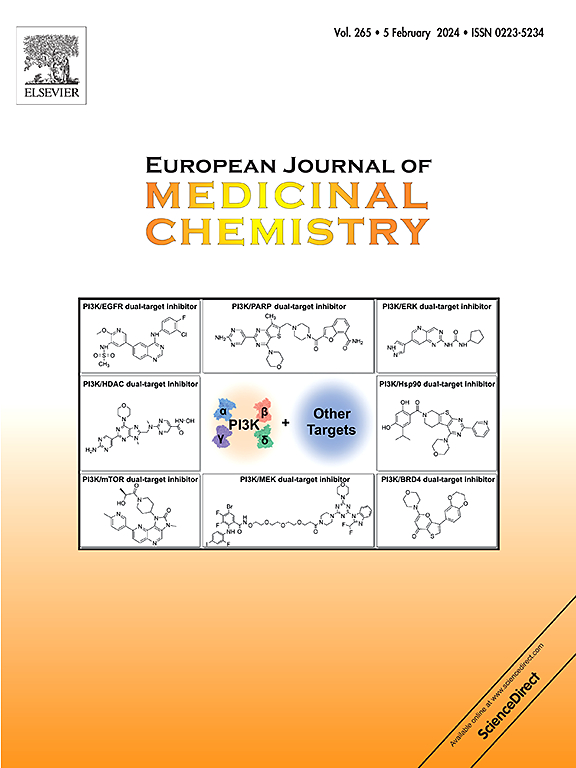具有重复亚基结构的高治疗指数α-螺旋抗菌肽抗多药耐药菌
IF 6
2区 医学
Q1 CHEMISTRY, MEDICINAL
引用次数: 0
摘要
抗菌肽(AMPs)的从头设计为通过合理设计克服天然抗菌肽的局限性提供了一种有希望的策略,为解决日益增长的传统抗生素耐药性风险提供了潜在的解决方案。在本研究中,利用α-螺旋模板(XXFY)n及其β-薄片对应物(KFKY)n (X = Lys, Dab, Orn或Arg)生成了一系列新的amp;F = Phe;Y = Leu, Ile, Phe,或Trp;K = Lys;n = 2、3、4或5),从而能够系统地研究它们的构效关系(SAR)。最佳肽27,命名为(OOFI)4 (O = Orn, I = Ile),对标准和多药耐药菌株均表现出有效的广谱抗菌活性,同时具有低溶血毒性。此外,27表现出较低的诱导抗性倾向,快速的杀菌效果,强大的膜破坏活性和免疫调节活性。值得注意的是,肽27在小鼠模型中对耐多药铜绿假单胞菌124诱导的肺部感染和mrsa诱导的皮肤感染也显示出显著的疗效。总之,本研究的SAR分析为基于模板的AMP设计提供了新的见解,新开发的肽27成为治疗临床相关耐药细菌感染的有希望的候选者。本文章由计算机程序翻译,如有差异,请以英文原文为准。

High therapeutic index α-helical antimicrobial peptides with repetitive subunit structures against multidrug-resistant bacteria
De novo design of antimicrobial peptides (AMPs) offers a promising strategy to overcome the limitations of natural AMPs through rational design, providing potential solutions to address the growing risk of traditional antibiotic resistance. In this study, a series of new AMPs were generated using the α-helical template (XXFY)n and its β-sheet counterpart (KFKY)n (X = Lys, Dab, Orn, or Arg; F = Phe; Y = Leu, Ile, Phe, or Trp; K = Lys; n = 2, 3, 4, or 5), enabling a systematic investigation of their structure-activity relationships (SAR). The optimal peptide 27, designated as (OOFI)4 (O = Orn, I = Ile), demonstrated potent broad-spectrum antimicrobial activity against both standard and multidrug-resistant bacterial strains, along with low hemolytic toxicity. Furthermore, 27 exhibited a low propensity for inducing resistance, rapid bactericidal effects, robust membrane-disrupting activity, and immunomodulatory activity. Notably, peptide 27 also showed remarkable efficacy in treating multidrug-resistant P. aeruginosa 124-induced lung infections and MRSA-induced skin infections in murine models. In conclusion, the SAR analysis in this study offers novel insights into template-based AMP design, and the newly developed peptide 27 emerges as a promising candidate for treating clinically relevant drug-resistant bacterial infections.
求助全文
通过发布文献求助,成功后即可免费获取论文全文。
去求助
来源期刊
CiteScore
11.70
自引率
9.00%
发文量
863
审稿时长
29 days
期刊介绍:
The European Journal of Medicinal Chemistry is a global journal that publishes studies on all aspects of medicinal chemistry. It provides a medium for publication of original papers and also welcomes critical review papers.
A typical paper would report on the organic synthesis, characterization and pharmacological evaluation of compounds. Other topics of interest are drug design, QSAR, molecular modeling, drug-receptor interactions, molecular aspects of drug metabolism, prodrug synthesis and drug targeting. The journal expects manuscripts to present the rational for a study, provide insight into the design of compounds or understanding of mechanism, or clarify the targets.

 求助内容:
求助内容: 应助结果提醒方式:
应助结果提醒方式:


